LL-9031 Q-TRAC Natural Sunlight Concentrator Accelerated Natural Outdoor Exposures
Technical Bulletins
Posted 2023
Last Updated 2023
LL-9031
Background
In the early 1900s, researchers began to assess the weatherability of materials by exposing specimens outdoors on vertical, south-facing racks. By 1908, members of ASTM Committee D-1 and the Paint Manufacturer’s Association began outdoor paint exposures in Atlantic City, New Jersey. To shorten test times, a 45 degree south-facing rack was developed to allow more sunlight to fall onto the specimens. The 45 degree rack was the first accelerated outdoor weathering method. Over the years accelerated outdoor weathering continued to evolve. By the 1930s a basic, single-axis, follow-the-sun rack was developed to track the sun from morning until night. It was first commercialized in the 1950s. Mirrors were added to the device in the 1960s to concentrate sunlight onto specimens for even greater acceleration.
evolve. By the 1930s a basic, single-axis, follow-the-sun rack was developed to track the sun from morning until night. It was first commercialized in the 1950s. Mirrors were added to the device in the 1960s to concentrate sunlight onto specimens for even greater acceleration.
The Q-TRAC Natural Sunlight Concentrator
The Q-TRAC ® Natural Sunlight Concentrator is an advanced, dualaxis accelerated natural weathering tester. It is an outdoor exposure device that automatically tracks the sun from morning to night and adjusts to compensate for seasonal changes in the sun’s altitude. At the same time, the Q-TRAC concentrator's mirrors reflect and con - centrate full-spectrum natural sunlight onto test specimens. This follow-the-sun solar concentrating system increases the amount of sunlight exposure specimens receive. The Q-TRAC is the most effective outdoor acceleration method available and it allows product evalu - ation in a reduced time period. Furthermore, compared to accelerated laboratory testers, there are fewer concerns over whether the simulated light matches sunlight, because the Q-TRAC concentra - tor's light source is natural sunlight. Although the Q-TRAC units are only operated in Arizona, they can be used to realistically simulate a number of end-use service environments. For example, South Florida conditions can be simulated with the addition of ultra-pure water spray. The quick, realistic, and reproducible results of the Q-TRAC make it an attractive testing option for many material types and end-use applications.
FYI: Fresnel - A Fresnel optic is made up of a series of flat segments rather than a single curved element. It is named after Augustin Fresnel, who in 1822, invented a lighthouse lens made up of a series of flat glass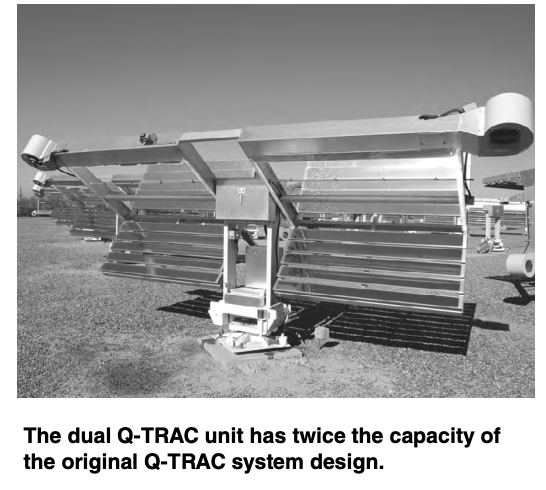 segments. Fresnel optics are often smaller, lighter and easier to produce than equivalent curved optics.
segments. Fresnel optics are often smaller, lighter and easier to produce than equivalent curved optics.
Concentrating Natural Sunlight
The Mirror Array. The Q-TRAC concentrator uses a series of 10 flat mirrors to produce the effect of a single larger curved mirror. This type of mirror array is called a Fresnel concentrator (pronounced Fruh-nell). As light strikes the mirrors, at nearly a 90 degree angle, it is reflected and is concentrated onto the target board (figure 1).
The mirror array is designed with a very narrow field of view of the sun. This ensures that the light reflected onto the target board is direct beam sunlight, not diffuse (or scattered) light.
Mirrors on a Q-TRAC are highly reflective and are cleaned by Q-Lab technicians at regular intervals to maintain reflectance. Whenever the spectral reflectance at 310 nm falls below 65 percent, the individual mirror is replaced.
Following the Sun:
Single-Axis. The single-axis sunlight concentrators of the 1960s can automatically track the azimuth (or the sun’s movement from east to west over the course of the day). These devices swivel horizontally from East to West. Since the earth rotates every 24 hours, the hourly change in azimuth is 15 degrees.
In order to truly follow the sun, it is also necessary to track the sun’s altitude, or the angle of the sun above the horizon. On single-axis devices, manual altitude adjustments must be performed every 2-3 weeks. Because the sun’s altitude changes every day, the dual-axis devices allow for a larger exposure area.
Dual-Axis. The dual-axis devices are able to automatically track both the azimuth and the altitude. To track the altitude, the Q-TRAC tilts vertically, accounting for both the sun’s seasonal altitude differences and daily arc changes. The Q-TRAC unit continuously and automatically tracks the azimuth and altitude to keep the mirror bed at normal incidence, or perpendicular to the sun (figure 2).
On the Q-TRAC natural sunlight concentrator, swivel and tilt movements are controlled by balanced sets of photoreceptor cells (solar cells) that are installed above the target board. One set of solar cells controls swivel movement, while the other set controls tilt movement. Each set of solar cells is equipped with a built-in shadow maker. In perfect focus, both sets of solar cells are equally illuminated, with neither cell shaded. When a cell starts to become shaded, the Q-TRAC system automatically adjusts to maintain focus (figure 3).

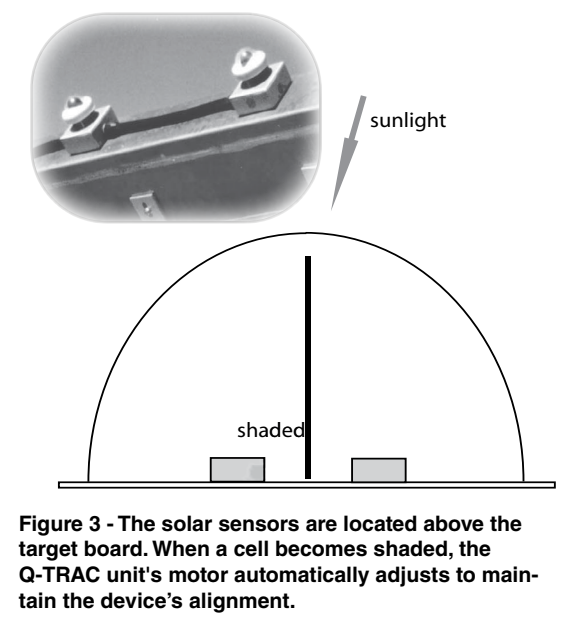
Clear, Sunny Days in Arizona
The Q-TRAC natural sunlight concentrator operates only during periods of bright, clear sunshine. In order for the Q-TRAC to effectively concentrate sunlight, it requires long, cloudless days with a low percentage of diffuse light and a low percentage of atmospheric moisture. As a general guideline, the amount of direct beam radiation, as measured by a 6 degree Pyrheliometer, should not fall below 600 W/m2 during the Q-TRAC system's operation. One of the few locations in the continental USA that provides ideal conditions, lots of sunshine and minimal atmospheric moisture, is Phoenix, Arizona. Climate Data is located in Appendix A.2.
Specimen Mounting & Cooling
The Target Board. The target board, located directly across from the mirror array, is where the specimens are mounted. On a Q-TRAC unit, the maximum length and width of the specimens cannot be larger than the length or width of the target area 66" x 5.5" (167.64 x 13.97 cm). In addition, specimen thickness is usually limited to 0.5” (13 mm) or less (figures 4 & 5).
Options for specimen mounting include backed, unbacked, and even under-glass. The specimens are considered “backed” when mounted directly to the target board with no space in between. Temperatures of backed specimens are higher than unbacked specimens.
Air Cooling System. The highly concentrated sunlight from the mirror array can create high temperatures on the target board. To maintain specimens at a reasonable temperature and to prevent thermal degradation, the target board is positioned under an air cooling duct. As air is forced through the duct, an air deflector directs a high volume of air across the specimens (figure 6).
FYI: Larger Specimen Area. Even though the target board has the same dimensions on both single and dual-axis concentrators, the area in which specimens can be mounted is actually larger on dual-axis concentrators. Since a single-axis device is unable to automatically make seasonal adjustments, the extreme ends of the target board periodically become shaded. Because of this shading, the usable specimen area on a single-axis device, is less than that on a dual-axis testers.
Most Q-TRAC unit test specimens are maintained at a temperature within approximately 10°C of identical specimens that are exposed on a conventional outdoor test rack.
In the event of power loss or airflow loss, a fail-safe clutch automatically releases, and gravity pulls the Q-TRAC Natural Sunlight Concentrator out of focus. This prevents the specimens from overheating.
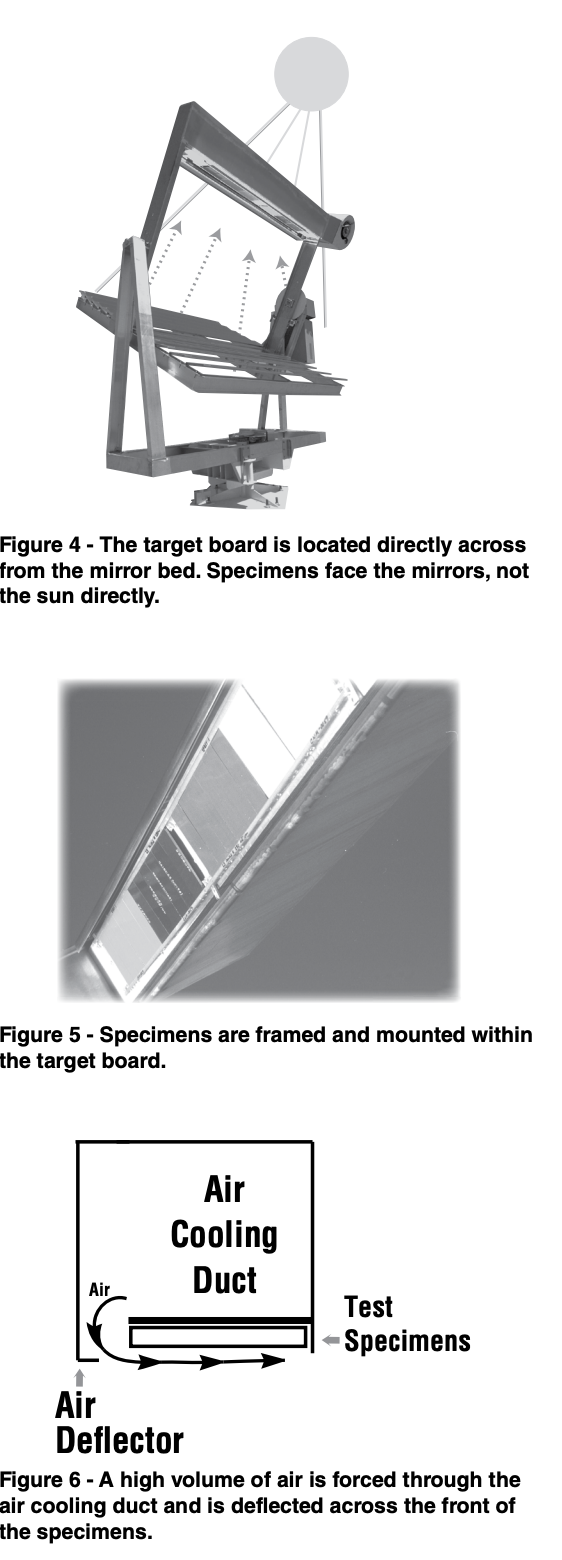
Simulating Moisture: Programmed Spray Cycles
Some applications require water spray cycles to effectively reproduce the end-use environment. The Q-TRAC has two standard water spray cycles, and can be programmed to realistically simulate thermal shock and/or nighttime wetting (dew).
Extremely pure water is applied with four fan spray nozzles located approximately 18 inches from the target board (figure 7). The spray nozzles apply a uniform fine spray onto the material at a rate of between 0.20-0.25 GPM (0.7569-0.9461 LPM).
At night, the Q-TRAC unit is rotated into a 5 degree inverted lock-down position, with the specimens facing upwards (figure 8). This important feature allows moisture to rest on specimens throughout the evening and provides a realistic simulation of the time of wetness (TOW) experienced in South Florida. Older single-axis devices, which are not capable of the 5 degree inverted position, provide significantly reduced moisture dwell time on the specimens.
The water used for Q-TRAC spray cycles is purified via a combination of reverse osmosis and deionization. High temperatures can cause unpurified water to etch the specimen surface. In addition, unpurified water can deposit contaminants onto the specimens. Both etch and contamination produce results that would not normally occur outdoors. As a precaution at Q-Lab Arizona, the water is checked and verified on a regular basis.
Simulating Florida Exposures. Moisture plays a key role in the weathering of materials in South Florida. To simulate the subtropical conditions with the Q-TRAC Natural Sunlight Concentrator, test specimens are exposed to daytime or nighttime water-spray cycles. There are two cycles used to replicate South Florida: Spray-1 and Spray-2.
Spray-1: During the day, material on the Q-TRAC concentrator is sprayed for 8 minutes each hour. At nightfall, the Q-TRAC system is inverted to the 5 degree lock-down position. Specimens are sprayed for 8 minutes at 9 p.m., midnight, and 3 a.m. to simulate dew formation. Spray-1 is particularly well suited for building materials, adhesives and some plastics (figure 9).
FYI: Rain & Dew. The major cause of outdoor product moisture damage is dew, not rain. In some geographic locations, outdoor products can remain wet for 15-hours per day.
Spray-2: Nighttime Wetting: During the evening, water spray cycles are programmed to run a 3-minute spray cycle followed by a 12-minute dry cycle, repeating four times each hour. This continues from 7:00 p.m. to 5:00 a.m. every night. During the day, there is no spray. Spray-2 is particularly well suited for certain coatings.
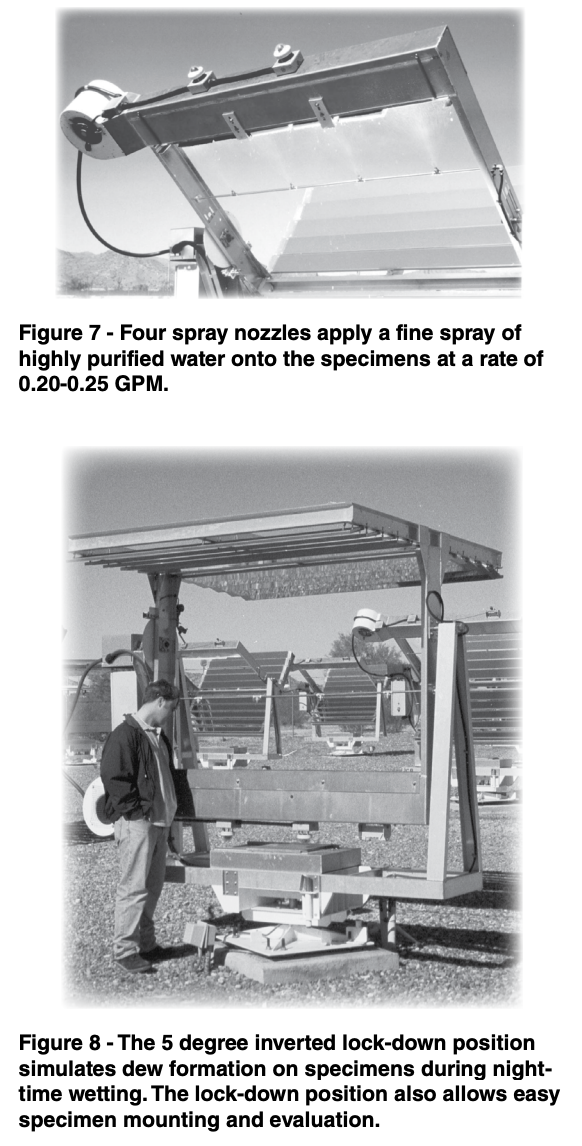
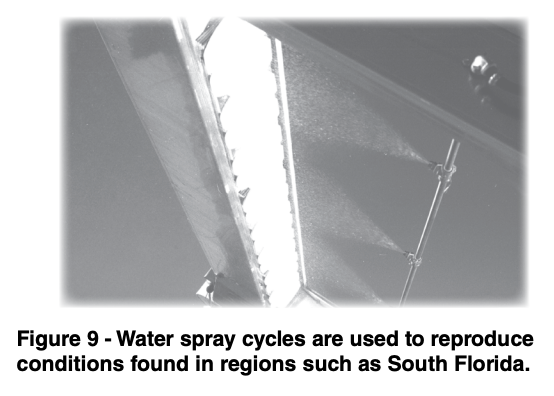
Timing a Test
There are several ways to time a Q-TRAC concentrator test. Test specimens can be removed when a pre-selected change occurs in a control specimen. Also, specimens may be timed according to a pre-selected loss of an original value (e.g. gloss or color) in the specimens themselves. Q-Lab recommends basing test times on accumulated ultraviolet (UV) exposure; although, timing may also be based on total solar radiant exposure.
Accumulated Ultraviolet Exposure. Timing tests on the basis of accumulated ultraviolet exposure is recommended because the UV portion of the solar spectrum causes the most damage to virtually all materials. Often, duration end points are determined using Florida (subtropical) or Arizona (arid) equivalent sun years. Equivalent sun years are based on the averages of data collected over many years of actual sunlight measurement (table 1).
Annually, the Q-TRAC will typically produce ~1420 MJ/m2 Total Ultraviolet (TUV). This is about the same amount of UV deposited over five years of Florida (subtropical) testing or 4.25 years of Arizona (arid) testing (figure 10). This is not meant to imply that the degradation that occurs over one year of Q-TRAC natural sunlight concentrator testing will necessarily be the same as five years of Florida testing. As with all accelerated testing, the amount of acceleration depends on many variables such as material composition, mode of degradation, temperature response and moisture. Generally speaking, however, one can expect 3 to 10 times acceleration over natural Florida exposures.
Measuring Radiant Exposure
The radiant energy specimens receive on the target board is not measured directly. Rather, accumulated radiant dosage is calculated by multiplying the solar energy that falls on the mirrors; times the number of mirrors; times the average reflectance efficiency of the mirrors.
A specially made, follow-the-sun tracking device continuously monitors the solar energy at near normal incidence. The tracking device is equipped with a Normal Incidence Pyrheliometer (NIP), and two Eppley Ultraviolet Radiometers (TUVR), (figure 11).
Measuring UV only. Two Eppley TUVR’s measure irradiance in the ultraviolet portion of the solar spectrum (295-385 nm). One TUVR equipped with a black painted shading disk measures diffuse-only radiation. The other TUVR measures the full 180 degree field of view to include both direct beam and diffuse radiation. A comparison of the shaded and un-shaded TUVR indicates how much direct beam ultraviolet falls on each Q-TRAC mirror. This is used as the basis for calculating accumulated TUV dosage.
Measuring UV, Visible & IR. A Normal Incidence Pyrheliometer (NIP) measures the total direct beam solar irradiance (250-3000 nm). The NIP has 6 degree field of view and uses a collimating tube to eliminate diffuse energy.
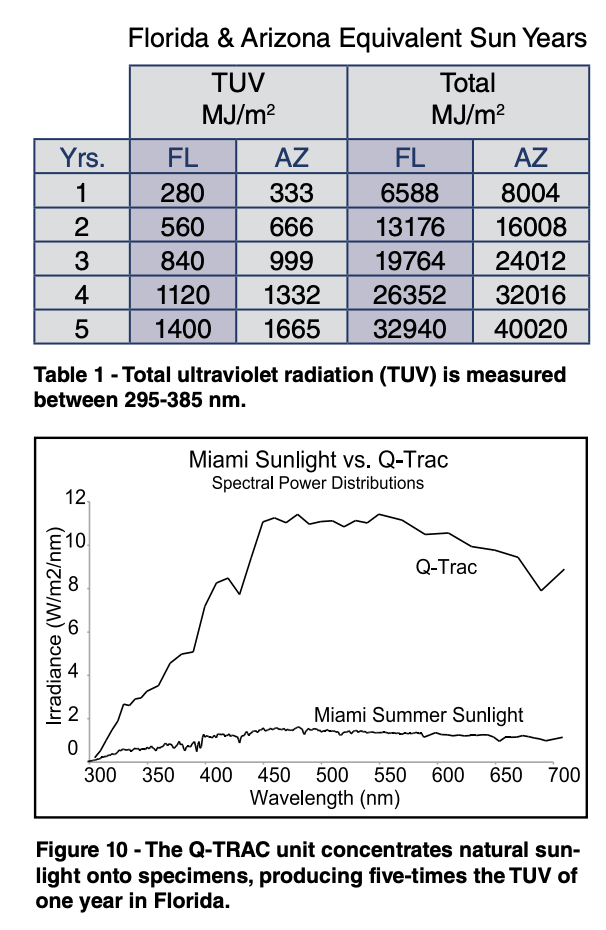
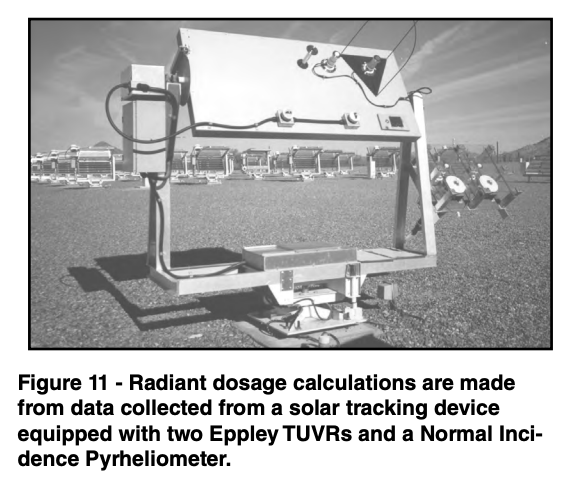
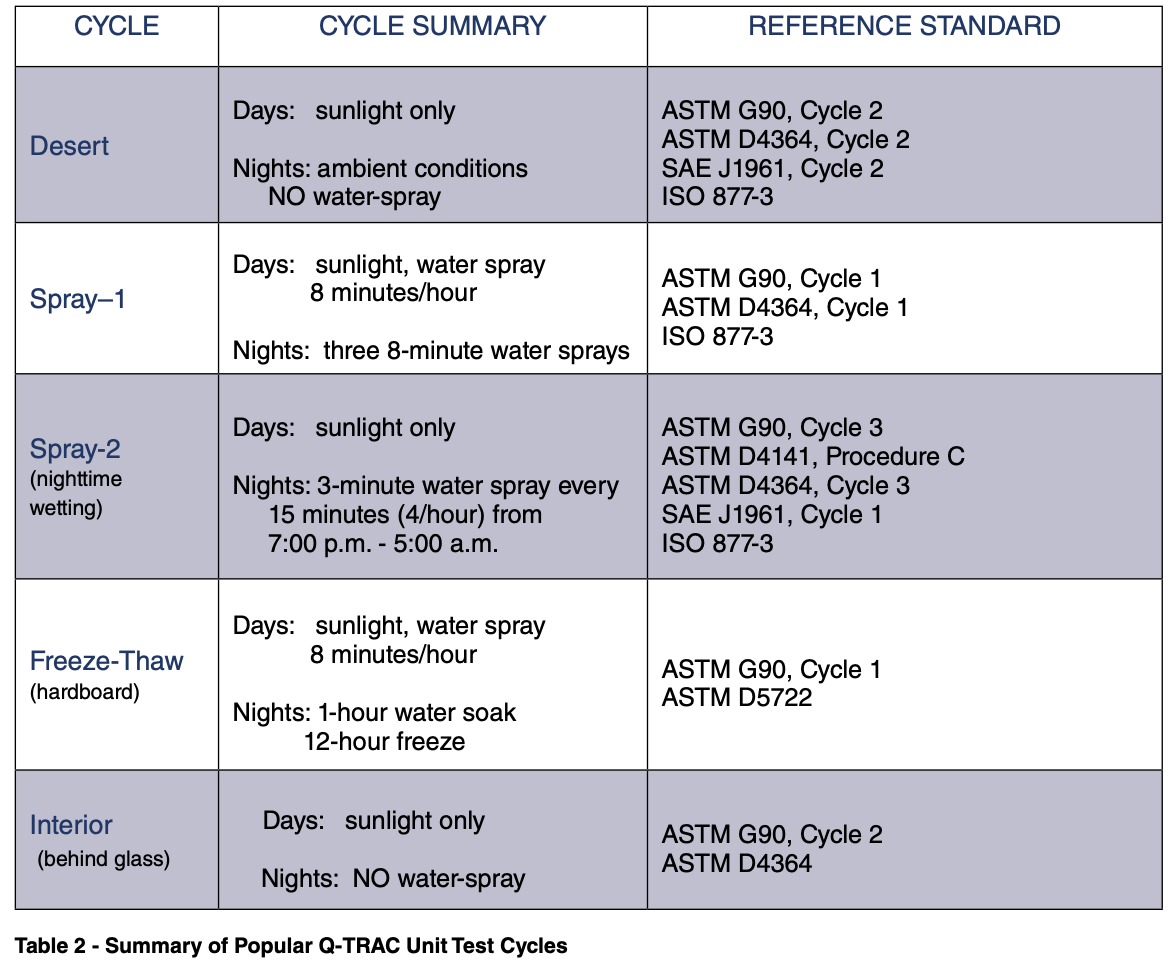
Freeze-Thaw, or Hardboard (ASTM D5722). During the day, specimens are exposed according to ASTM G90, Spray-1. In the evening the entire mounting frame (specimens included) is removed from the Q-TRAC concentrator. Specimens are immersed in a deionized water soak tank maintained at 21°C ± 3°C (70°F ± 5°F) for one hour. After soaking, the mounting frame (with specimens) is placed in a freezer (which is maintained at -18°C [0°F ]) for 12 hours.
The following morning, specimens thaw in ambient laboratory conditions for a minimum of one hour. The mounting frame (with specimens) is remounted on the Q-TRAC unit for another day of outdoor exposure. This cycle is used to quickly and accurately evaluate finish failure involving loss of film integrity, such as cracking, peeling, and flaking of factory-coated embossed hardboard.
Q-TRAC Concentrator Summary
Natural Sunlight Concentrators have been used to accelerate natural outdoor weathering conditions since the 1960s. The Q-TRAC Natural Sunlight Concentrator is an advanced, dual-axis device that tracks the sun from morning until night while automatically compensating for seasonal changes in the sun’s altitude. A highly reflective mirror array reflects and concentrates sunlight onto test specimens. In one year, Q-TRAC specimens receive about five times the amount of ultraviolet exposure accumulated in one year of Florida testing. This makes product evaluation possible in a greatly reduced time period.
Since the Q-TRAC unit most effectively concentrates during periods of bright, clear sunshine, it is only operated in Phoenix, AZ where the climate conditions are optimal. Water spray cycles can be programmed for daytime or nighttime wetting to simulate various end-use conditions. At night, the Q-TRAC rests in a 5 degree lock-down position, which allows longer, more realistic moisture dwell times.
APPENDIX A.1 Q-TRAC Unit Test Methods*
ASTM G90, Standard Practice for Performing Accelerated Outdoor Weathering of Nonmetallic Materials Using Concentrated Natural Sunlight.
ASTM D4141, Standard Practice for Conducting Accelerated Outdoor Exposure Tests of Coatings.
ASTM D4364, Standard Practice for Performing Outdoor Accelerated Weathering Tests of Plastics Using Concentrated Sunlight.
ISO 877-3, Plastics – Methods of exposure to solar radiation – Part 3: Intensified weathering using concentrated solar radiation.
SAE J1961, Accelerated Exposure of Automotive Exterior Materials Using A Solar Fresnel Reflector Apparatus.
APPENDIX A.2 Arizona Site Climate Profile
Latitude: 33˚ 23' North
Longitude: 112˚ 35' West
Elevation: 1055 feet

*ASTM Test Methods may be purchased from: ASTM International, 100 Barr Harbor Drive, PO Box C700, West Conshohocken, PA 19428-2959 USA. Telephone: (610) 832-9585. Website: www.astm.org
*ISO Test Methods may be purchased from: International Organization for Standardization 1, rue de Varembé, Case postale 56 CH-1211 Geneva 20, Switzerland. Telephone: +41 22 749 01 11. Website: www.iso.org
*SAE Test Methods may be purchased from: SAE World Headquarters, 400 Commonwealth Drive, Warrendale, PA 5096-0001 USA. Telephone: 1-877-606-7323. Website: www.sae.org
Recommendations for Developing a Well-Rounded Test Program
Predicting the future is always difficult, but knowing how well your product will last outdoors is too important to leave to chance. Because no accelerated test can replicate all of the things that can occur outdoors, Q-Lab recommends that all testing programs should include natural exposures in Florida and/or Arizona. These inexpensive benchmark exposures give the researcher baseline, real-world data.
Accelerated weathering and light stability tests allow relative evaluations and predictions in a greatly reduced amount of time. Testing with at least one accelerated test with a device such as the Q-TRAC Natural Sunlight Concentrator (or Q-SUN® Xenon Test Chamber or QUV® Accelerated Weathering Tester) can help you bring a product to market much faster. The accelerated test that you choose should be optimized for the material and the end-use application.
This combined approach allows you to proceed with confidence: Florida and Arizona outdoor exposures provide a solid baseline, while the accelerated test gives fast data on new developments.
Notes:
Q-TRAC Natural Sunlight Concentrator testing service is available at Q-Lab Arizona. Q-Lab does not sell the Q-TRAC device itself to third parties.
Q-Lab Weathering Research Service is a division of Q-Lab Corporation.